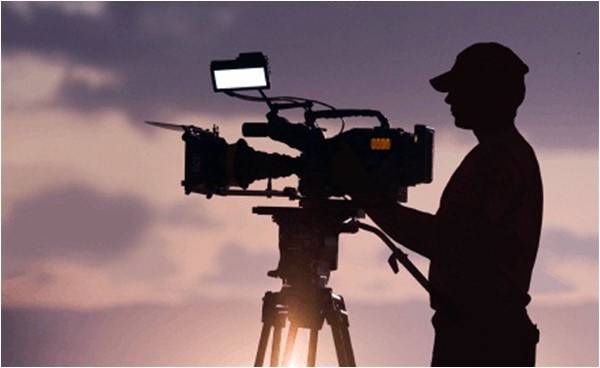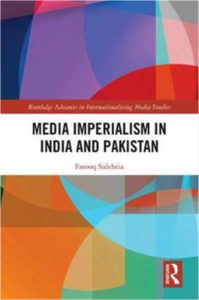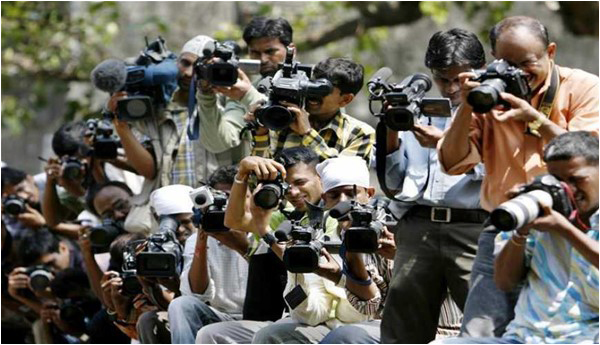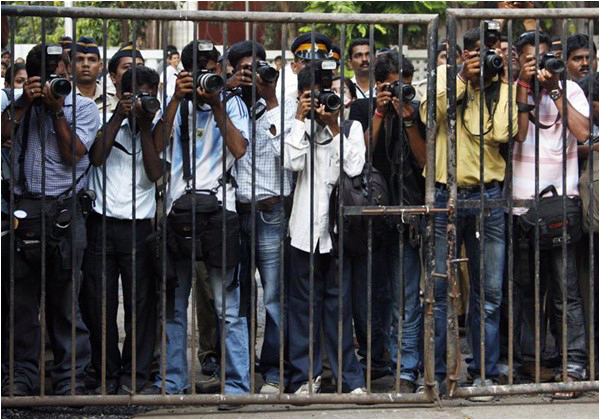
“Technology is not neutral”. “Global media and the globalisation of media are not the same thing”. “All talk of corruption in India distracts from the real problems — government policies and growing inequality”.
Such big issues, you might think, would each merit a book-length discussion but Farooq Sulehria successfully weaves these mighty themes into a provocative tapestry of thoughts. His recently published Media Imperialism in India and Pakistan, based on his PhD thesis from the School of Oriental and African Studies (SOAS) at the University of London, dissects the current media scene in both countries and uncovers much that should concern us.
Early on, Sulehria outlines the Marxist definition of imperialism which goes beyond domination and control, power and oppression. Lenin, for example, linked ‘imperialism’ to western capitalist exploitation of the rest of the world. And for Sulehria, ‘media imperialism’ rests on two fundamental concepts: exploitative domination and dependency. The point is, as Sulehria argues: technology is never ‘neutral’. Television arrived in the ‘post-colonial’ world with all the ‘baggage’ of the modernisation theory that can be summed up as “The rest will be best when they’re more like the West”. Television technology was conceived, designed and mostly built in the West so, inevitably, newly emerging nations were forced to rely on Western expertise not just for the hardware but also for the ‘software’ in terms of know-how and training. Sulehria complains that this ‘dependency’ on Western practices means there is now little originality or relevance in the output.The present ‘monoculture’ of the Indian and Pakistani mediscapes is geared more to amusing the urban middle classes than to addressing the pressing needs of the ‘missing millions’, whose daily struggles rarely make even the news scrolls on the bottom of our screens.

As with many newly independent states, television was first introduced in India to promote national integration, education, modern agricultural practices, birth control, hygiene and so on. Meanwhile, in Pakistan, General Ayub sold himself as ‘the great moderniser’ and agitated for the introduction of television as a vital sign of progress. Looking at Indian television today, it is hard to imagine a time when the government was once reluctant to introduce commercials onto DD (Doordarshan). Indeed, Sulehria argues that following globalisation, public interest output that reflects the interests of all citizens has all but disappeared. When DD and PTV monopolised the airwaves, their broadcasts were universally available.But since the introduction of cable and niche TV channels and the switch to digital, the countryside and the urban poor have been marginalised. Furthermore, this fragmentation of the audience does not promote a healthy democracy. As Sulehria observes, media globalisation only serves to undermine and subvert a sense of community.
As a former journalist, Sulehria knows which questions to ask. With the liberalisation of the television systems in India and Pakistan in the 1990s, both countries became ‘rich pickings’ for Western media firms, technology companies, advertising agencies and trainers. Sulehria casts his trained eye over the areas of training and news production. Although PTV has had a training academy since 1981, when the private news channels hit the air in Pakistan they employed Western trainers to help them achieve the “lively, aggressive and colourful” appeal of CNN as one interviewee confided.

Similarly, when it comes to news production, few channels reflected the fact that over 60% of the citizens of both countries live in poverty. With the exception of the English-language daily The Hindu, none of the television channels or mainstream English-language dailies has ‘poverty’ as a regular ‘beat’, covered by a dedicated correspondent. On the other hand, crime, sports, lifestyle/showbiz and politics are all seen as important ‘beats’ with their own reporters.
While most television executives claim they want to produce television “with a distinctively Indian and South Asian identity”, their output tells a different story. According to one particular executive: “Every time you give an idea for a show, if he’s undecided about it [the Vice Chair] says, “Is there a precedence in the West?” That’s exactly how he asks — in plain terms, unabashedly.”
And that is exactly what Sulehria sees as the real impact of globalisation on the Indian and Pakistani media: a reliance on production and content as practised in the West; a macro-level shift towards entertainment when looking at the two television systems overall; and a race to the bottom regarding the representation of women from patriarchal perspectives and a tendency to equate money with power and progress. No, Big Brother is not going to get us out of this one.

The ‘watchdog’ role of the media has long been seen as an important safeguard in democracies where openness and transparency are seen as key to good governance — or so the story goes. Fake news and social media may well have quashed that notion. Still, Sulehria devotes a whole chapter to the topic of corruption as a consequence of media globalisation. First, he takes issue with the widely held view of corruption which would criminalise the ‘bribe-takers’ while letting the ‘bribe-givers’ off the hook. Secondly, he examines the ways in which media can be corrupted: low-paid journalists forced to take bribes in order to survive; the launching of television channels to buy influence; the placing or withdrawal of lucrative advertising campaigns; the employment of relatives or ‘favoured’ individuals. Ironically, the historically revered Fourth Estate is now seen by big business merely as ‘Real Estate’. According to the media critic Vanita Kohli-Khandekar, hyper-competition is testing the moral mettle of the media world. And it’s we who end up losing.
If there is a criticism, it is that the book reads too much like a traditional PhD thesis. Sulehria’s insight and creative thinking might be better served by a more free-flowing format. But that’s a minor point. This is an important piece of research that raises important questions for every democracy. Who gives us our news and how do we choose?
Dr Linda Mitchell is currently a Teaching Fellow in the Department of Politics at SOAS, University of London. The theme of her thesis was the role of the media in peacebuilding in post-conflict societies
Such big issues, you might think, would each merit a book-length discussion but Farooq Sulehria successfully weaves these mighty themes into a provocative tapestry of thoughts. His recently published Media Imperialism in India and Pakistan, based on his PhD thesis from the School of Oriental and African Studies (SOAS) at the University of London, dissects the current media scene in both countries and uncovers much that should concern us.
Early on, Sulehria outlines the Marxist definition of imperialism which goes beyond domination and control, power and oppression. Lenin, for example, linked ‘imperialism’ to western capitalist exploitation of the rest of the world. And for Sulehria, ‘media imperialism’ rests on two fundamental concepts: exploitative domination and dependency. The point is, as Sulehria argues: technology is never ‘neutral’. Television arrived in the ‘post-colonial’ world with all the ‘baggage’ of the modernisation theory that can be summed up as “The rest will be best when they’re more like the West”. Television technology was conceived, designed and mostly built in the West so, inevitably, newly emerging nations were forced to rely on Western expertise not just for the hardware but also for the ‘software’ in terms of know-how and training. Sulehria complains that this ‘dependency’ on Western practices means there is now little originality or relevance in the output.The present ‘monoculture’ of the Indian and Pakistani mediscapes is geared more to amusing the urban middle classes than to addressing the pressing needs of the ‘missing millions’, whose daily struggles rarely make even the news scrolls on the bottom of our screens.

As with many newly independent states, television was first introduced in India to promote national integration, education, modern agricultural practices, birth control, hygiene and so on. Meanwhile, in Pakistan, General Ayub sold himself as ‘the great moderniser’ and agitated for the introduction of television as a vital sign of progress. Looking at Indian television today, it is hard to imagine a time when the government was once reluctant to introduce commercials onto DD (Doordarshan). Indeed, Sulehria argues that following globalisation, public interest output that reflects the interests of all citizens has all but disappeared. When DD and PTV monopolised the airwaves, their broadcasts were universally available.But since the introduction of cable and niche TV channels and the switch to digital, the countryside and the urban poor have been marginalised. Furthermore, this fragmentation of the audience does not promote a healthy democracy. As Sulehria observes, media globalisation only serves to undermine and subvert a sense of community.
As a former journalist, Sulehria knows which questions to ask. With the liberalisation of the television systems in India and Pakistan in the 1990s, both countries became ‘rich pickings’ for Western media firms, technology companies, advertising agencies and trainers. Sulehria casts his trained eye over the areas of training and news production. Although PTV has had a training academy since 1981, when the private news channels hit the air in Pakistan they employed Western trainers to help them achieve the “lively, aggressive and colourful” appeal of CNN as one interviewee confided.

Similarly, when it comes to news production, few channels reflected the fact that over 60% of the citizens of both countries live in poverty. With the exception of the English-language daily The Hindu, none of the television channels or mainstream English-language dailies has ‘poverty’ as a regular ‘beat’, covered by a dedicated correspondent. On the other hand, crime, sports, lifestyle/showbiz and politics are all seen as important ‘beats’ with their own reporters.
While most television executives claim they want to produce television “with a distinctively Indian and South Asian identity”, their output tells a different story. According to one particular executive: “Every time you give an idea for a show, if he’s undecided about it [the Vice Chair] says, “Is there a precedence in the West?” That’s exactly how he asks — in plain terms, unabashedly.”
And that is exactly what Sulehria sees as the real impact of globalisation on the Indian and Pakistani media: a reliance on production and content as practised in the West; a macro-level shift towards entertainment when looking at the two television systems overall; and a race to the bottom regarding the representation of women from patriarchal perspectives and a tendency to equate money with power and progress. No, Big Brother is not going to get us out of this one.

The ‘watchdog’ role of the media has long been seen as an important safeguard in democracies where openness and transparency are seen as key to good governance — or so the story goes. Fake news and social media may well have quashed that notion. Still, Sulehria devotes a whole chapter to the topic of corruption as a consequence of media globalisation. First, he takes issue with the widely held view of corruption which would criminalise the ‘bribe-takers’ while letting the ‘bribe-givers’ off the hook. Secondly, he examines the ways in which media can be corrupted: low-paid journalists forced to take bribes in order to survive; the launching of television channels to buy influence; the placing or withdrawal of lucrative advertising campaigns; the employment of relatives or ‘favoured’ individuals. Ironically, the historically revered Fourth Estate is now seen by big business merely as ‘Real Estate’. According to the media critic Vanita Kohli-Khandekar, hyper-competition is testing the moral mettle of the media world. And it’s we who end up losing.
If there is a criticism, it is that the book reads too much like a traditional PhD thesis. Sulehria’s insight and creative thinking might be better served by a more free-flowing format. But that’s a minor point. This is an important piece of research that raises important questions for every democracy. Who gives us our news and how do we choose?
Dr Linda Mitchell is currently a Teaching Fellow in the Department of Politics at SOAS, University of London. The theme of her thesis was the role of the media in peacebuilding in post-conflict societies

